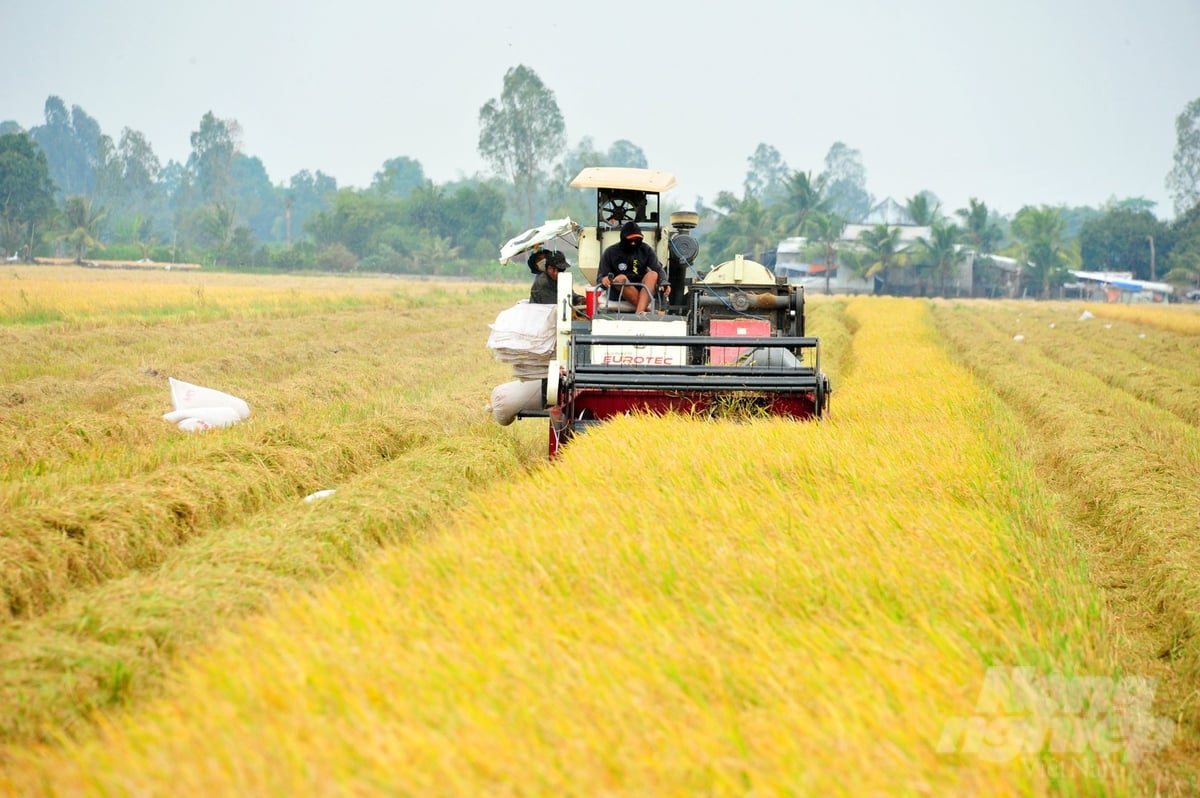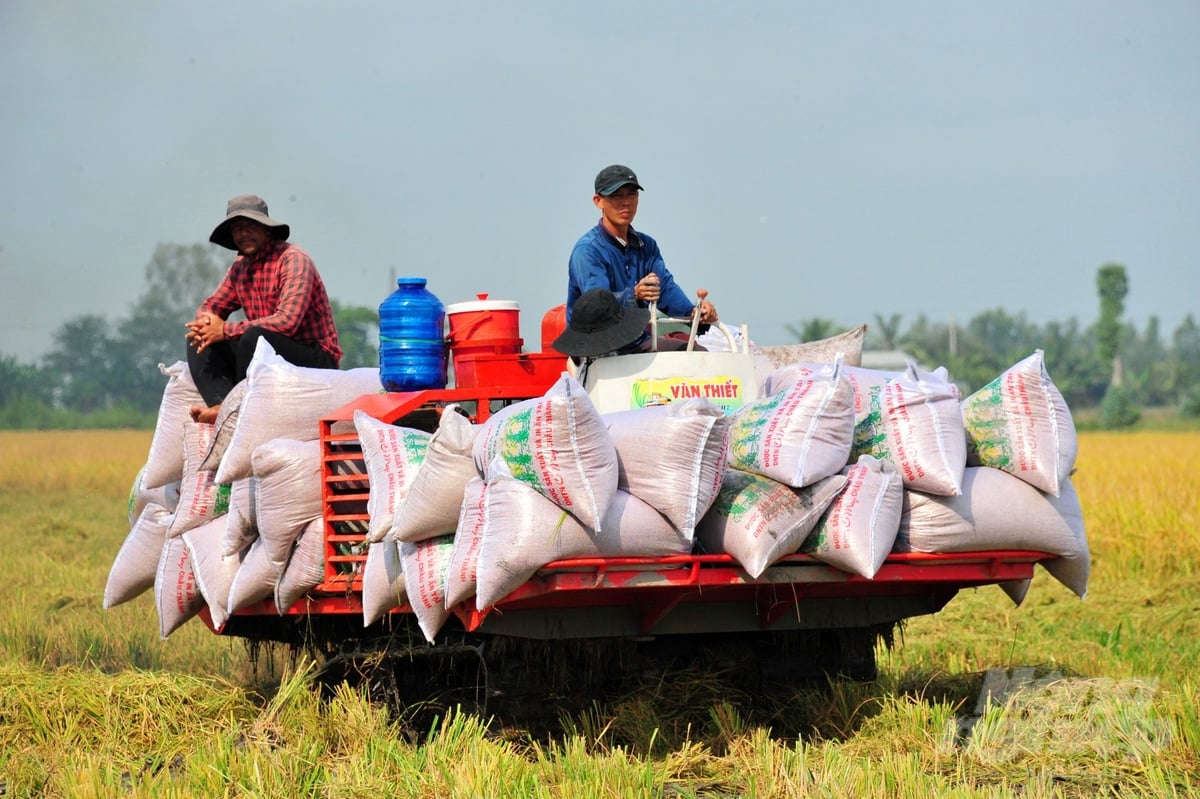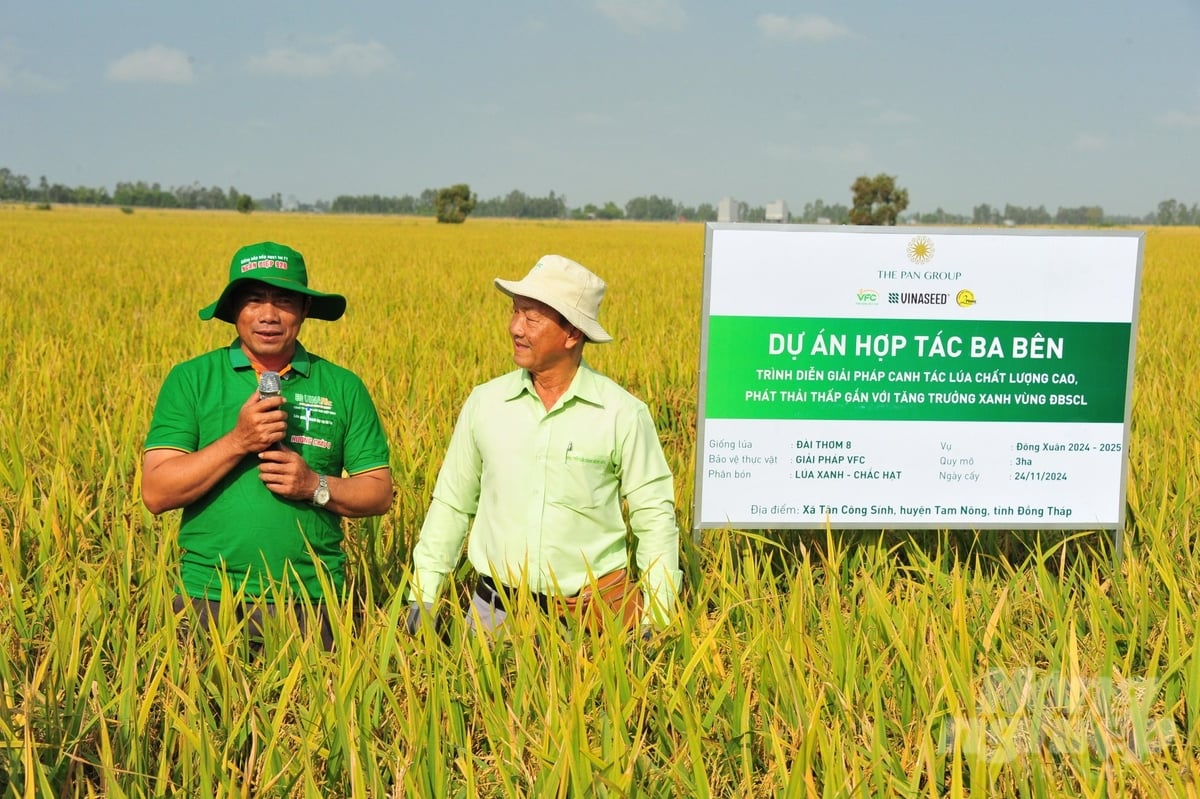November 23, 2025 | 06:44 GMT +7
November 23, 2025 | 06:44 GMT +7
Hotline: 0913.378.918
November 23, 2025 | 06:44 GMT +7
Hotline: 0913.378.918
In the 2024-2025 winter-spring season, the sustainable value chain-based, low-emission rice cultivation model in the Mekong Delta, led by PAN Group in collaboration with Binh Dien II (2 Phong brand), has shown good results. Accordingly, PAN Group's units, together with Binh Dien II partners, have researched and tested a comprehensive cultivation solution based on the "1 must, 5 reductions" criteria.

Farmers in the Mekong Delta are entering the peak harvest season for the 2024-2025 winter-spring rice crop. Photo: Le Hoang Vu.
Mr. Tran Vu Chi’s household in Tan Cong Sinh commune, Tam Nong district, Dong Thap province, which is participating in the model, shared: In the 2024-2025 winter-spring season, his family cultivated 3 hectares of Dai Thom 8 rice following the high-quality, low-emission rice cultivation process associated with green growth in the Mekong Delta. The amount of rice seed used was reduced to 6 kg per cong (1,300 m²), instead of the previous 10-12 kg per cong. Pesticides were applied only 5 times per crop, compared to 8-10 times as before, and the amount of fertilizer used was also significantly reduced.
Farmers participating in this model are guaranteed a stable price for their rice through Vinaseed’s processing plants. At the end of this winter-spring season, Mr. Chi reported that production costs had been reduced by 40-50%, with a yield of approximately 9 tons per hectare and a profit of 1.360 USD per hectare.
When visiting Mr. Chi’s field on harvest day, Mr. Ngo Van Lanh, a farmer from the same Tan Cong Sinh commune, evaluated that the rice in the model field had longer panicles, firmer and more uniform grains, and a higher yield of 100-150 kg per cong compared to conventional cultivation methods. Additionally, the reduction of several input factors helped farmers save on costs, making the model more sustainable and economically efficient for local farmers.
The three-way cooperation in implementing the model demonstrates that sustainable development for all parties can only be achieved when farmers earn higher profits. This approach highlights the importance of making farmers the central focus of the rice value chain.
Mr. Bui Ba Bong, Chairman of the Vietnam Rice Industry Association, emphasized that in order to create rice production models that reduce input costs and ensure stable consumption for farmers, it is crucial for cooperatives, local authorities, and businesses to play an active role in supporting farmers.

Building sustainable connections is a key factor that helps farmers reduce production costs and increase profits. Photo: Le Hoang Vu.
According to Mrs. Nguyen Thi Tra My, CEO of PAN Group and Chairwoman of the Board of Directors of Vietnam Seed Corporation (Vinaseed), improving farmers' income is not simply about businesses committing to buying rice at a price higher than the market rate. This approach, she suggests, may not be a sustainable solution in the long run. Instead, she emphasizes that farmers and businesses should work together to form sustainable supply chains that cover all stages, from input materials and service provision to purchasing, processing, and branding.
Mr. Truong Cong Cu, CEO of Vietnam Sterilization Joint Stock Company (a subsidiary of PAN Group), shared: "We are very excited to build this model. As a business, our goal should typically be to sell as much as possible, but we do not encourage farmers to use excessive pesticides. Instead, we promote the use of the right amount and the most efficient methods to reduce production costs:.
This model not only helps increase farmers' income but also significantly contributes to the goal of reducing emissions in the agricultural sector. It does so through a comprehensive solution package that includes improved seeds, fertilizers, pesticides, and the alternate wetting and drying irrigation method.

The low-emission rice cultivation model in the 2024-2025 winter-spring season helps farmers reduce costs by 40-50%, achieve a yield of about 9 tons/ha, and generate a profit of 1.3600 USD/ha. Photo: Le Hoang Vu.
Mr. Le Quoc Phong, Chairman of the Board of Directors of Binh Dien II Fertilizer Production and Trading Joint Stock Company (2 Phong brand), affirmed that the project has successfully achieved its dual objectives by not only reducing the use of fertilizers, seeds, pesticides, and labor costs but also indirectly reducing greenhouse gas emissions.
"The project has achieved two key goals: farmers benefit from the reduced costs, while we also meet the emission reduction targets, contributing to a cleaner environment. Specifically, the amount of seed used has decreased from 100kg/ha to 60kg/ha, the number of fertilizer applications per crop has been reduced from 6 times to 3 times, and pest management has been cut down from 10 times to 5 times", Mr. Phong explained.
Businesses hope that this process will be recognized by the Ministry of Agriculture and Environment, and that it will be widely implemented in the 1 million hectares of high-quality, low-emission rice project. This initiative is aimed at promoting green growth in the Mekong Delta region.
Additionally, Rize Vietnam, an agricultural technology company from Singapore, conducted emission measurements on the model fields, using the Gold Standard certification process. Their findings show a reduction of 4 tons of CO2 emissions per hectare.
Mr. Tran Thanh Tam, Head of the Sub - Department of Crop Production and Plant Protection in Dong Thap, shared that the province is working towards the goal of reaching 50,000 hectares of low-emission rice cultivation by 2025 under the "1 Million hectares of high-quality, low-emission rice" project.
At present, various localities in the province have implemented numerous models of cooperation between farmers, cooperatives, and businesses to produce high-quality, low-emission rice. Among these, the three-way collaboration model involving VFC, Vinaseed, and Binh Dien II has been particularly effective in closely managing input materials, reducing production costs, and ultimately increasing profits for local farmers.
Translated by Phuong Linh

(VAN) Results from the Sustainable Durian Model Project in Dak Lak have confirmed the critical role of Yara Viet Nam in transferring advanced nutritional solutions to farmers.

(VAN) In Tuyen Quang province, livestock farmers have introduced effective models and innovative practices that significantly strengthen African Swine Fever prevention and control efforts.

(VAN) This is the study conducted by IRRI and Can Tho University on the rice straw value chain in Mekong Delta showing an economic potential of more than 6.6 trillion VND/year.

(VAN) By participating in cooperative economics, many farmers in Tay Ninh have overcome hardship, mastered clean dragon fruit cultivation techniques.

(VAN) The crossbreeding program in the former Binh Dinh province (now part of Gia Lai) has shown signs of decline, and urgent measures are needed to revive it and sustain past achievements.

(VAN) The agricultural sector agreed on a roadmap to pilot the MRV protocol and expand low-emission rice production from the 2025-2026 winter-spring crop.

(VAN) Agricultural extension officers in Quang Ninh do more than transmit knowledge; they have become a steadfast support system for farmers on the path to sustainable agricultural development.